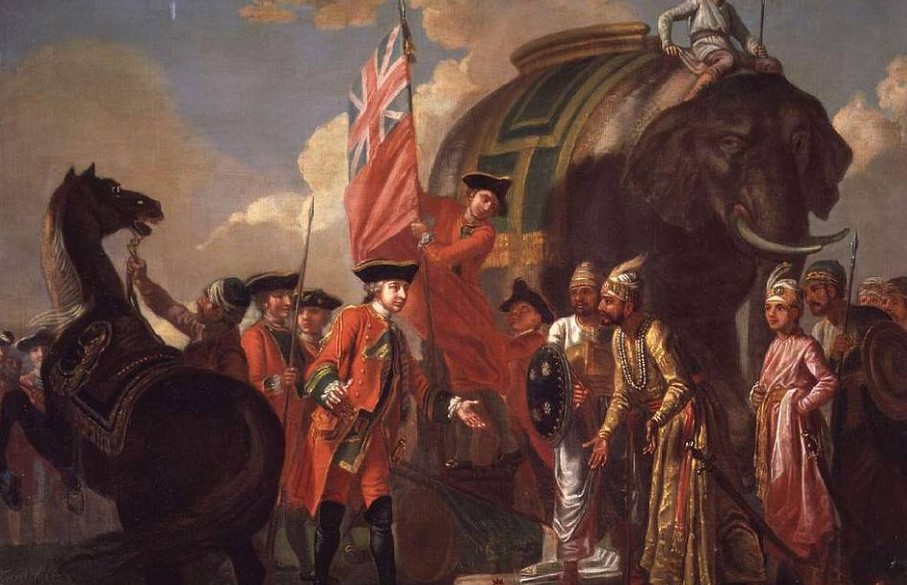
Modern History MCQs – 2 (Battle of Plassey and Battle of Buxar)
Most important multiple choice questions from the chapter – Battle of Plassey and Battle of Buxar MCQs.
Home » UPSC Study Materials » Prelims Express » Chapterwise MCQs » Modern History MCQs » Modern History MCQs – 1 (Arrival of Europeans in India)
Arrival of Europeans MCQs with answers and explanations for preparation of UPSC, State PSCs and Other Examinations
Q 1. The first European to arrive in India using the sea route was ?
A. Vasco da Gama
B. Selukas Niketar
C. Columbus
D. Zamorin
Correct Answer: [A] Vasco da Gama
From 7th century onwards, India’s merchandise trade with European countries was dominated by Arabs who did not allow any other to encroach these routes.
However, it was the Portuguese who discovered alternative sea routes to India. Portuguese traveler Vasco da Gama discovered an alternate route from Portugal to India via Cape of Good Hope. He first reached India in May 1498 in Calicut.
Portuguese were also the first Europeans to settle and colonise India. They came to India mainly to trade in spices but gradually made their colonies here.
Q 2. The English East India Company was established in the year ?
A. 1600
B. 1608
C. 1613
D. 1664
Correct Answer: [A] 1600
The English East India Company was established on 31 December 1600 as per the Royal Charter issued by the Queen of England, Elizabeth I.
It was the first among various East India Companies formed by different European countries. The list of other East India Companies are as follows:
Q 3. Who among the following is regarded as the real founder of the Portuguese colonial empire in India ?
A. Vasco da Gama
B. Francisco de Almeida
C. Columbus
D. Afonso de Albuquerque
Correct Answer: [D] Afonso de Albuquerque
Q 4. Who among the following was the last East India company to be formed ?
A. British East India Company
B. Dutch East India Company
C. Portuguese East India Company
D. French East India Company
Correct Answer: [D] French East India Company
Q 5. Joseph Francois Dupleix belonged to ?
A. British East India Company
B. Dutch East India Company
C. Portuguese East India Company
D. French East India Company
Correct Answer: [D] French East India Company
Q 6. English East India Company established their first factory in ?
A. Goa
B. Surat
C. Bombay
D. Masulipatnam
Correct Answer: [B] Surat
Q 7. Fort Saint George, the first fort built by the British in India was located at ?
A. Goa
B. Kolkata
C. Bombay
D. Madras
Correct Answer: [D] Madras
Q 8. The privileges of free trade rights were granted to the English East India Company in 1717 by the Mughal Emperor ?
A. Bahadur Shah
B. Shahjahan
C. Jahangir
D. Farrukh-Siyar
Correct Answer: [D] Farrukh-Siyar
Q 9. Bombay was handed over to East India Company by ?
A. Portuguese
B. Charles II
C. Jahangir
D. French
Correct Answer:
[B] Charles II
Q 10. Peace treaty of ‘Aix-la-Chapelle’ was signed between the British and ?
A. Portuguese
B. Mughals
C. Dutches
D. French
Correct Answer: [D] French
More questions are coming soon. Join us on Whatsapp for latest updates: Join CivilsCracker on Whatsapp

Most important multiple choice questions from the chapter – Battle of Plassey and Battle of Buxar MCQs.

Most important multiple choice questions from the chapter – Social and Religious Reform Movements MCQs.

Most important multiple choice questions from the chapter – Anglo Mysore Wars and Anglo Maratha Wars MCQs.

Most important multiple choice questions from the chapter – Governor Generals of India MCQs.

Most important multiple choice questions from the chapter – Revolt of 1857 MCQs.

Most important multiple choice questions from the chapter – Organizations before Indian National Congress MCQs.

Most important multiple choice questions from the chapter – Important Sessions of Indian National Congress MCQs.

Most important multiple choice questions from the chapter – Partition of Bengal and Swadeshi Movement MCQs.

Most important multiple choice questions from the chapter – Surat Split and Lucknow Pact MCQs.

Most important multiple choice questions from the chapter – Arrival of Gandhi and Jallianwala Bagh Massacre MCQs.

Most important multiple choice questions from the chapter – Khilafat and Non Cooperation Movement MCQs.

Most important multiple choice questions from the chapter – Simon Commission and Nehru Report MCQs.

Most important multiple choice questions from the chapter – Civil Disobedience Movement MCQs.

Most important multiple choice questions from the chapter – Communal Award and Poona Pact MCQs.

Most important multiple choice questions from the chapter – Individual Satyagraha and Cripps Mission MCQs.

Most important multiple choice questions from the chapter – Quit India Movement MCQs.

Most important multiple choice questions from the chapter – Indian National Army and Royal Indian Navy Mutiny MCQs.

Most important multiple choice questions from the chapter – Cabinet Mission and Formation of Constituent Assembly MCQs.

Most important multiple choice questions from the chapter – Independence and Partition of India MCQs.
We are adding new Notes, Chapterwise MCQs, Quizzes, Previous Years Questions everyday
We are adding new Notes, Chapterwise MCQs, Quizzes, Previous Years Questions everyday